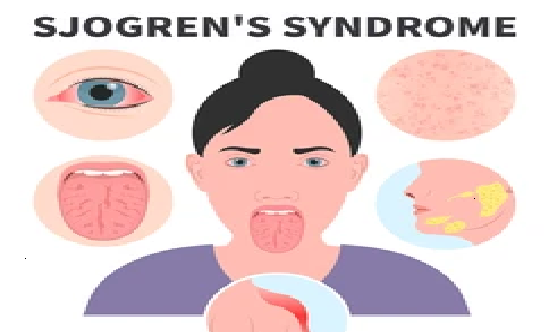Sjögren’s disease, or Sjögren’s syndrome, is an autoimmune disorder primarily affecting moisture-producing glands, leading to symptoms of dry mouth and dry eyes. It can also impact other organs and cause systemic symptoms. Here’s a breakdown of Sjögren’s syndrome:
Types
- Primary Sjögren’s Syndrome: Occurs on its own without any other associated autoimmune disease.
- Secondary Sjögren’s Syndrome: Occurs in conjunction with other autoimmune diseases, such as rheumatoid arthritis or lupus.
Symptoms
- Dry Eyes (Keratoconjunctivitis Sicca): A gritty, itchy sensation in the eyes due to reduced tear production.
- Dry Mouth (Xerostomia): Leads to difficulty swallowing, speaking, and can cause an increase in dental cavities.
- Joint Pain and Stiffness: Often affects the hands and knees.
- Swollen Salivary Glands: Particularly under the jaw and in front of the ears.
- Systemic Symptoms: Fatigue, skin rashes, and dry skin.
Complications
- Dental Issues: Increased risk of cavities and oral infections due to lack of saliva.
- Lung Problems: Dryness and inflammation can affect the lungs.
- Kidney Issues: Renal tubular acidosis or interstitial nephritis.
- Neurological Issues: Peripheral neuropathy or cognitive dysfunction in severe cases.
- Increased Risk of Lymphoma: Although rare, people with Sjögren’s have a slightly elevated risk.
Causes
The exact cause is unknown, but it’s believed to involve genetic predisposition and environmental factors. The body’s immune system mistakenly attacks its moisture-producing glands, leading to dryness and other symptoms.
Diagnosis
Diagnosing Sjögren’s syndrome can be challenging and often includes:
- Blood Tests: Checking for specific antibodies like anti-SSA (Ro) and anti-SSB (La).
- Schirmer’s Test: Measures tear production to confirm dry eyes.
- Salivary Gland Biopsy: Examines salivary gland tissue for immune cell infiltration.
- Imaging: Sialography or ultrasound to assess gland structure.
Treatment
While there is no cure, treatment focuses on symptom management and includes:
- Artificial Tears and Saliva Substitutes: To alleviate dryness.
- Medications: Cholinergic drugs to stimulate saliva, immunosuppressants, or corticosteroids for systemic symptoms.
- Dental and Eye Care: Regular check-ups and maintaining hydration can help reduce complications.
Lifestyle Recommendations
- Hydration: Drinking plenty of water helps manage dryness.
- Humidifiers: Useful for maintaining moisture in the air at home.
- Diet: Soft, moist foods can be easier to eat for those with dry mouth.
If you have specific questions about Sjögren’s syndrome, feel free to ask!
